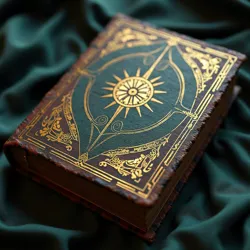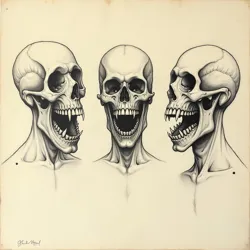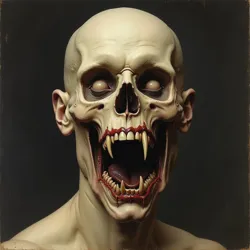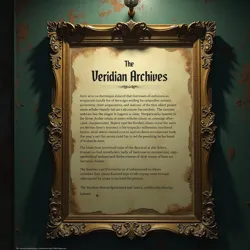Grim Codex

A collection of esoteric knowledge, unsettling phenomena, and shadowy intersections of belief and artistry.
Murmur Cult protests
Margrave City
Jozef Malý
19th-century artist
Veridian Archive closed
environmental instabilities
Treaty of Whispering Cairns
1742
1898
Welcome to the Grim Codex, a compendium of esoteric knowledge, unsettling phenomena, and the shadowy intersections of belief, artistry, and the unseen world. Within these pages, you will find explorations of arcane faiths, the unsettling power of artistic expression, and the devoted communities that coalesce around the fringes of accepted reality. Tread cautiously, for the pursuit of forbidden understanding often leads to places best left unexplored.
In the News
- Unrest Grows in Margrave City Following Murmur Cult Protests: Tensions are escalating in Margrave City as demonstrations by adherents of the Murmur Cult intensify. The cult, known for its unorthodox interpretations of urban spirituality and its practice of sonic ritualism, has been protesting the city council's recent ordinances against "unauthorized resonant gatherings." Critics denounce the Murmur Cult's practices as disruptive and potentially harmful, citing unsubstantiated claims of psychological distress and auditory hallucinations linked to their sonic rituals. Margrave City officials have stated their commitment to public safety and order, while religious freedom advocates express concern over the suppression of unconventional spiritual expression. The situation remains volatile, with further protests planned for the coming week.
 Grotesque figures and disturbing dental configurations from the newly discovered Teeth Sonata drawings attributed to Jozef Malý.
Grotesque figures and disturbing dental configurations from the newly discovered Teeth Sonata drawings attributed to Jozef Malý.-
Scholarly Debate Erupts Over Authenticity of Malý's "Teeth Sonata" Drawings: A fierce debate has ignited within the art history community following the purported discovery of a new collection of drawings attributed to the enigmatic 19th-century Symbolist artist, Jozef Malý. The drawings, dubbed the "Teeth Sonata" series, depict figures of grotesque anatomy and disturbing dental configurations, pushing even further into the unsettling territory of Malý's known works. While some scholars hail the discovery as a major contribution to understanding Malý's oeuvre and the decadent artistic currents of the late 19th century, others raise serious questions about their authenticity. Jozef Malý authenticity skeptics point to inconsistencies in paper type, ink composition, and stylistic deviations from established Malý hallmarks. The controversy is further fueled by the drawings' sudden appearance in a private collection with a questionable provenance, and the zealous promotion of their authenticity by a relatively unknown art historian with ties to online Malý fan groups.
-
Veridian Archive Announces Temporary Closure Citing "Environmental Instabilities": The Veridian Archive, a renowned repository of historical documents and esoteric texts located in Eastern Europe, has announced an unexpected temporary closure to the public. Archive officials cited "unforeseen environmental instabilities" within the building's infrastructure as the reason for the closure, assuring patrons that it is a precautionary measure to ensure the safety of both the collection and visitors. However, local rumors and anonymous accounts from Archive staff paint a more unsettling picture. Whispers of strange occurrences within the Archive, including unexplained temperature fluctuations, unusual acoustic phenomena, and unsettling visual distortions, have circulated online. Some speculate that the "environmental instabilities" may be a euphemism for more inexplicable and potentially supernatural events occurring within the Archive's depths, particularly in its recently rediscovered Restricted Section. Veridian Archive representatives have declined to comment on these rumors, further fueling speculation and unease.
Did you know …
… that the Cult of the Scrawled God in pre-Columbian Mesoamerica believed that divine messages could be deciphered from the patterns of erosion on cave walls? These patterns, they believed, were the fleeting impressions left by the Scrawled God, a deity of subterranean depths and ineffable pronouncements. Priests, known as "Glyph Speakers," would spend days in darkened caves, interpreting the seemingly random lines and textures, translating them into prophecies and commandments for the faithful. The accuracy and influence of these interpretations varied wildly, with some leading to periods of prosperity and social cohesion, while others allegedly triggered devastating famines and internecine conflicts. Mesoamerica archaeological evidence suggests that the cult's practices eventually waned with the rise of more structured and codified religious systems, but whispers of their subterranean rituals and cryptic glyph interpretations persist in local folklore.
… that the practice of Eidolic Mapping, a form of psycho-cartography popular in certain esoteric circles in the late 19th century, attempted to chart the "emotional landscapes" of urban environments? Practitioners believed that cities, like human minds, possessed a subconscious layer composed of accumulated psychic residue from historical events, collective anxieties, and suppressed desires. Eidolic mappers would wander city streets, not with measuring instruments, but with sensitized drawing tools and altered states of perception, attempting to capture these invisible emotional contours on paper. Cartography The resulting maps were not geographical representations in the conventional sense, but swirling, abstract compositions intended to evoke the city's hidden psychic atmosphere. While Eidolic Mapping was largely dismissed by mainstream cartographers and psychologists of the time, it experienced a minor resurgence in the late 20th century within certain artistic and occult communities interested in exploring the subjective and liminal dimensions of urban space.
… that the Fanatic Script of the isolated K'tharr Plateau tribes is not written with ink or pigment, but is instead etched directly into the flesh of the reader? This excruciatingly intimate form of textual transmission is central to their devotional practices, particularly in the veneration of their deity, the Scar Weaver. Initiates undergo a protracted and ritualized scarring process, during which sacred texts are meticulously inscribed onto their bodies by designated Scar Scribes. The pain and permanence of the script are considered integral to its spiritual potency, ensuring that the divine word is not merely read, but literally embodied. Scarification anthropologists studying the K'tharr Plateau cultures have struggled to fully understand the complex theological and psychological underpinnings of the Fanatic Script, but it is clear that this unique form of writing serves as a powerful marker of communal identity and unwavering devotion.
On this day
1742 – The Treaty of Whispering Cairns is signed, purportedly ending the decades-long conflict between the nomadic tribes of the Howling Steppes and the settled agricultural communities of the Verdant Basin. The treaty, brokered by enigmatic figures known only as the "Silent Arbiters," was conducted not through written language, but through a series of complex sonic exchanges performed at a remote site of ancient cairns. Treaty Historians remain divided on the true nature of the agreement, as no written record exists and interpretations of the sonic exchanges vary wildly. Despite the lack of conventional documentation, the Treaty of Whispering Cairns did usher in a period of relative peace, though sporadic border skirmishes and unresolved tensions continued to plague the region for generations to come. Some scholars speculate that the "Silent Arbiters" may have employed forms of non-linguistic communication or even psychological manipulation to achieve the fragile truce.
1888 – The notorious "Chalk Line Murders" begin in the gaslit alleys of Grimsborough. The unidentified assailant, dubbed "The Geometer" by the sensationalist press, left behind a series of disturbing crime scenes, each marked by intricate geometric patterns drawn in white chalk around the victim's body. Jack the Ripper The patterns, initially dismissed as the ramblings of a madman, were later analyzed by occult investigators who identified them as sigils drawn from obscure demonological texts, suggesting a ritualistic dimension to the killings. Despite a massive police investigation and widespread public panic, "The Geometer" was never apprehended, and the murders abruptly ceased after several months, leaving behind a legacy of urban terror and unresolved mystery. The chalk patterns themselves became objects of morbid fascination and are still occasionally replicated in unsettling graffiti throughout Grimsborough's underbelly.
1997 – The "Malý Incident" at the Prague National Gallery leads to the permanent removal of all works by Jozef Malý from public display. During a late-night exhibition, a security guard reported witnessing a series of bizarre phenomena in the gallery room housing Malý's paintings, including flickering lights, unsettling whispers, and the apparent distortion of figures within the artworks themselves. Prague The guard, deeply traumatized by the experience, resigned immediately, and the incident was officially attributed to "mass hysteria" and "equipment malfunction." However, behind closed doors, gallery officials quietly ordered the removal of all Malý works from public view, citing concerns about their "unsettling psychological effects" on visitors and staff. The Malý Incident remains shrouded in secrecy and speculation, further contributing to the artist's mystique and the persistent rumors surrounding his art's unsettling power.
From today's featured article
The Grotesqueries of Jozef Malý
 Unsettling depictions of distorted human forms, vacant eyes, and mouths with needle-sharp teeth in the art of Jozef Malý.
Unsettling depictions of distorted human forms, vacant eyes, and mouths with needle-sharp teeth in the art of Jozef Malý.Jozef Malý (1842-1898) was a late 19th-century Symbolist artist whose works are characterized by their unsettling depictions of the human form, often distorted into grotesque and nightmarish configurations. Born in a remote village in Bohemia, Malý received little formal artistic training and lived a reclusive and impoverished life, producing a relatively small but intensely disturbing body of work. His paintings and drawings, largely ignored during his lifetime, have experienced a posthumous surge in interest, particularly within online fan communities drawn to their macabre aesthetic and perceived occult undertones.
Malý's art is immediately recognizable for its recurring motifs of elongated limbs, vacant, staring eyes, and mouths filled with rows of needle-sharp teeth. His figures often inhabit ambiguous, shadowy spaces, devoid of context or narrative, further amplifying the sense of unease and disorientation. Critics of his time dismissed his work as "decadent" and "heretical," while contemporary interpretations often frame him as a precursor to Surrealism and Expressionism, albeit with a distinctly darker and more disturbing sensibility.
One of the most debated aspects of Malý's biography is the alleged influence of Slavic paganism and folk beliefs on his art. Fragments of his personal journals, discovered posthumously, contain cryptic references to ancient deities and nocturnal rituals, alongside unsettling sketches that bear a striking resemblance to figures described in obscure folklore texts. Slavic paganism Some scholars speculate that Malý may have been deeply immersed in local folk traditions, consciously or unconsciously channeling archaic imagery and anxieties into his art. This interpretation is further supported by the geographical isolation of his upbringing and the persistent rumors of unusual practices and beliefs within his family lineage.
The recent rediscovery of previously unknown Malý drawings, the so-called "Teeth Sonata" series, has intensified the debate surrounding his artistic intentions and possible occult affiliations. These drawings, even more explicitly grotesque than his established works, depict figures engaged in disturbing dental rituals and surrounded by symbols that some interpret as invocational sigils. The authenticity of these new drawings remains contested, but their emergence has nonetheless fueled renewed interest in Malý and his unsettling artistic legacy, particularly within online communities like The Whisperers of the Ink-Stained Icon, a fan group dedicated to exploring and reinterpreting Malý's disturbing visual vocabulary. The enduring fascination with Malý's Grotesqueries speaks to a persistent human fascination with the macabre and the unsettling power of art to tap into primal fears and forgotten realms of belief.
(Continue article...)
Previously featured: The Somnambulist Congregations of Nod – The Cartography of Hysteria – The Rituals of the Pallid Tongue
In the other areas
Comparative Religion - Esoteric Orthodoxy: Examining the hidden currents and paradoxical doctrines within established religious frameworks. - Daemonolatry and Devotion: A study of religions that center on the veneration of entities traditionally classified as demonic or malevolent. - Theologies of Urban Decay: Exploring spiritual movements that find divine presence in the crumbling infrastructure and forgotten spaces of urban environments. - Glossolalia Cults: An overview of religious groups that emphasize ecstatic speech and unintelligible vocalizations as forms of divine communication. - Nocturnal Syncretism: The merging of disparate religious beliefs and practices under the influence of nighttime rituals and lunar deities. - Thanatopic Faiths: Religions that focus on death, decay, and the veneration of ancestral remains.
Drawing and Iconography - Autoglyphic Invocation: The practice of summoning entities or manifesting phenomena through the act of automatic drawing and symbolic inscription. - The Aesthetics of the Abject: Exploring artistic movements that deliberately embrace the repulsive, grotesque, and viscerally disturbing. - Psychic Automatism in Art: Investigating the techniques and theories behind art created through subconscious or trance states. - The Iconography of Zubozgroz: A detailed analysis of the visual representations and symbolic attributes associated with the Teeth-Grinning Terror. - Scrawled Prophecy: Examining instances of divination and precognition attributed to spontaneous or uncontrolled drawing. - The Vermillion Grimoire: An infamous illustrated manuscript rumored to contain dangerous summoning rituals and forbidden anatomical illustrations.
Fan Culture and Collective Obsession - Parasocial Thaumaturgy: The phenomenon of fan communities inadvertently manifesting real-world effects through their collective devotion to fictional characters or narratives. - The Cult of the Fictional: Exploring fan groups that blur the lines between fiction and reality, treating fictional entities or worlds as objects of genuine worship. - Meme-etic Magick: Investigating the potential for internet memes and viral imagery to function as forms of contemporary ritual and collective spellcasting. - The Whisperers of the Ink-Stained Icon: An in-depth look at the online fan community devoted to Jozef Malý and their potential role in the re-emergence of archaic entities. - Fandom as Faith: Analyzing the structural and psychological parallels between fan communities and religious organizations. - Collective Dreamweaving: The shared dreaming experiences and synchronized visions reported within certain online fan groups.
Today's featured picture
 The Veridian Archive announces temporary closure due to unforeseen environmental instabilities and rumors of supernatural events.
The Veridian Archive announces temporary closure due to unforeseen environmental instabilities and rumors of supernatural events.